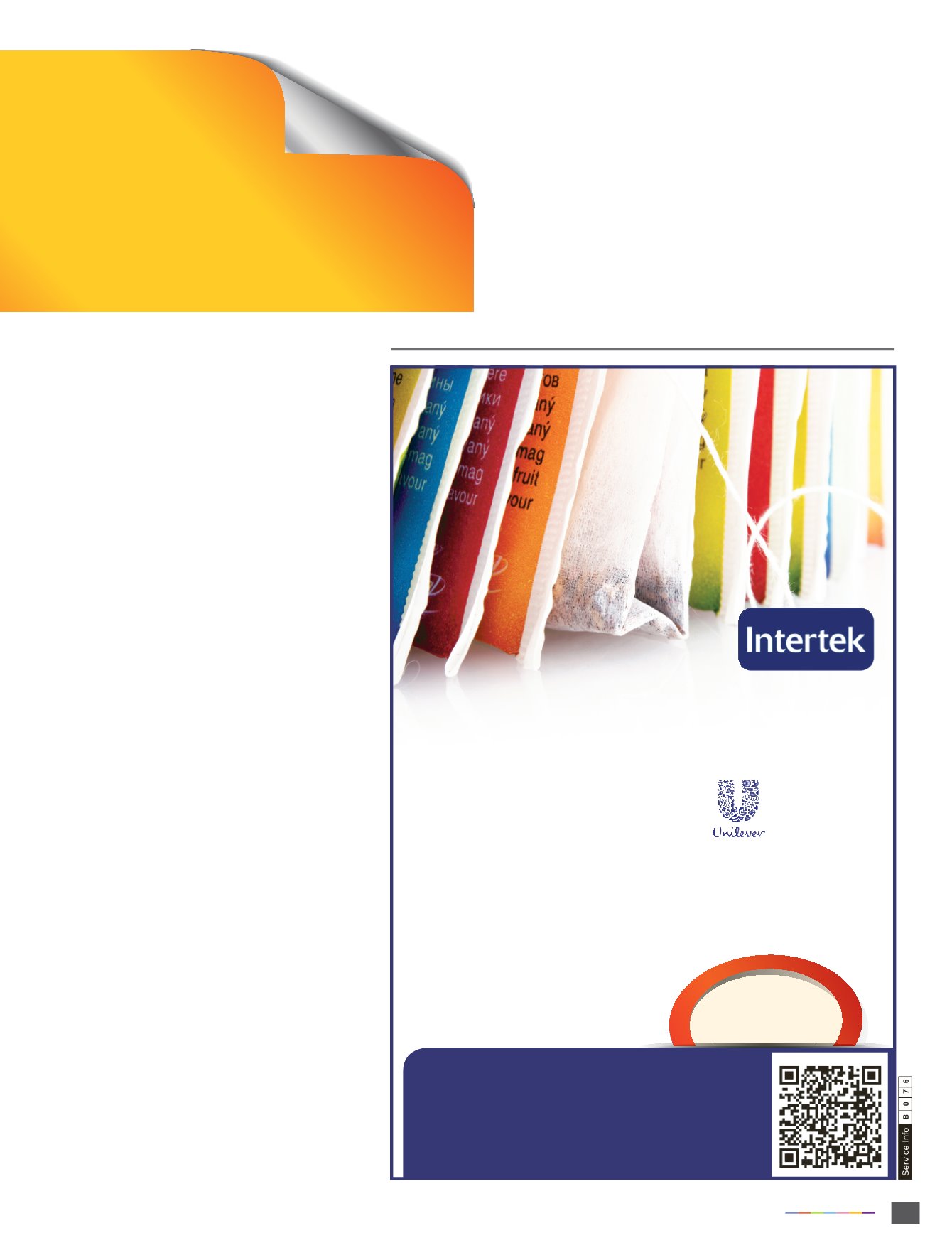
Food Focus Thailand
AUGUST 2013
35
Our Service
• Agricultural Testing
• Food Testing
• Food Inspection
• Food Certification
• Food Auditing
• Food Advisory
• Food Packaging Testing
• Food Physical Safety Analysis
• Food Service Equipment
• Food Training Service
Accepted By
Intertek is
A SQA Audit Provider
V
al
u
e
Q
u
a
l
i
ty
.
D
e
l
i
v
e
r
e
d
.
Intertek Industry and Certification Services
(Thailand) Limited
539/2 Gypsum Metropolitan Tower, 11C Floor Sri Ayudhya Road,
Tanon Phayathai Sub-district, Ratchathewi, Bangkok 10400
Tel.: (66 2) 248 1817 (auto)
Fax.: (66 2) 248 5707 (auto)
E-mail:
website:
ICMSF แบ
งประเภทของข
อกำหนดทางจุ
ลิ
นทรี
ย
เป
น 3 ประเภทใหญ
ๆ ดั
งนี้
1. มาตรฐานอาหารทางจุ
ลชี
ววิ
ทยา โดยมี
จุ
ดประสงค
เพื่
อให
อาหารมี
ความปลอดภั
ยทั้
งอาหารที่
ผลิ
ตภายใน
ประเทศและอาหารที่
ส
งออก
2. แนวปฏิ
บั
ติ
ทางจุ
ลชี
ววิ
ทยา เพื่
อให
ผู
ผลิ
ตอาหาร
และอื่
นๆ ได
ควบคุ
มและผลิ
ตอาหารให
มี
จุ
ลิ
นทรี
ย
ให
อยู
ใน
ระดั
บที่
ต่
ำเมื่
อผลิ
ตอาหารโดยใช
หลั
กปฏิ
บั
ติ
ที่
ดี
หรื
อเก็
บ
รั
กษาอาหารในสภาวะที่
เหมาะสม โดยแนวปฏิ
บั
ติ
นี้
มี
ความแตกต
างกั
นไปตามแต
ละผู
ผลิ
ตถึ
งแม
ว
าอาจ
เป
นผลิ
ตภั
ณฑ
ชนิ
ดเดี
ยวกั
นและเป
นแนวทางที่
ทำให
ระบบ HACCP ดำเนิ
นไปอย
างมี
ประสิ
ทธิ
ภาพ
3. คุ
ณลั
กษณะของอาหารทางจุ
ลชี
ววิ
ทยา ใช
ในการ-
ทำความตกลงระหว
างผู
ผลิ
ตและผู
จำหน
าย รวมทั้
ง
อาจเป
นข
อเสนอแนะจากองค
กรระดั
บชาติ
หรื
อนานาชาติ
ซึ่
งมั
กเป
นการยอมรั
บหรื
อปฏิ
เสธผลิ
ตภั
ณฑ
ในแต
ละครั้
ง
ที่
ผลิ
ต ซึ่
งกำหนดไว
ในข
อตกลงดั
งกล
าว
แผนการสุ
มตั
วอย
าง (Sampling Plans) ของ
ICMSF แบ
งได
ดั
งนี้
1. Two-Class Plan
เป
นแผนการสุ
มตั
วอย
างที่
แบ
ง
ตั
วอย
างไว
เป
น 2 กรณี
คื
อ ยอมรั
บ (Accept) หรื
อปฏิ
เสธ
(Reject) โดยพิ
จารณาจากการปรากฏของจุ
ลิ
นทรี
ย
หรื
อ
ปริ
มาณของจุ
ลิ
นทรี
ย
ที่
มี
ในตั
วอย
าง แผนการสุ
มตั
วอย
าง
วิ
ธี
นี้
กำหนด ดั
งนี้
n หมายถึ
ง ปริ
มาณของหน
วยของตั
วอย
างที่
ใช
ทดสอบ
m หมายถึ
ง ปริ
มาณของหน
วยของตั
วอย
างที่
มี
ค
าสู
ง
เกิ
นจนไม
เป
นที่
ยอมรั
บ ถ
าการยอมรั
บหรื
อปฏิ
เสธตั
วอย
าง
ตั
ดสิ
นจากการปรากฏหรื
อไม
ปรากฏของจุ
ลิ
นทรี
ย
ดั
งนั้
น
m = 0
c หมายถึ
ง ปริ
มาณสู
งสุ
ดของจำนวนตั
วอย
างที่
ยอมให
มี
หรื
อตั
วอย
างที่
มี
ปริ
มาณสู
งกว
าค
า m
ตั
วอย
าง เนื้
อปู
สุ
กแช
เยื
อกแข็
ง กำหนดไว
ดั
งนี้
Staphylococcus aureus
n = 5, c = 0 และ m = 10
3
/กรั
ม
จากตั
วอย
างที่
สุ
มจำนวน 5 ตั
วอย
าง เพื่
อนำมา
วิ
เคราะห
ปริ
มาณของ
S. aureus
ถ
าพบว
าทุ
กตั
วอย
าง
Information used in Determining Food Standard Criteria
Determining various types of food standard criteria, information must be
considered to establish requirements such as epidemiology information,
level or quantity of microbe that causes the spoilage of food, level of
microbial contamination acceptable under Good Manufacturing Practice,
the period for food used in growth of microbe or survival of pathogen, and
growth of microbe while food storage, during production, during product
distribution, point and cause of contamination of microbe during food
production, product distribution and during distribution, food consumption
behavior of consumer, group of target consumer, and method, including
reliability and accuracy of method used in food analysis.
ICMSF divides microbial requirement into three main types as
follows;
1. Microbiological Food Standard with the purpose of ensuring food
safety for both food produced locally and food for export.
ชนิ
ดของจุ
ลิ
นทรี
ย
แบ
งตามระดั
บ
ความรุ
นแรงในการก
อโรค / Types of
microbes divided according to danger
ระดั
บความรุ
นแรง:
อั
นตรายปานกลางและมั
กระบาดในวงกว
าง
Level:
Moderate dangerous and often widespread outbreak
จุ
ลิ
นทรี
ย
/Microorganism:
Salmonella typhimurium, Salmonella
ซี
ไร
ไทป
อื่
นๆ,
Shigella sonnei
และ
S. flexneri, Vibrio parahaemolyticus,
Escherichia coli
(Enteropathogenic), Beta hemolytic streptococcus
ที่
มา/Source: Garbutt (1997)


